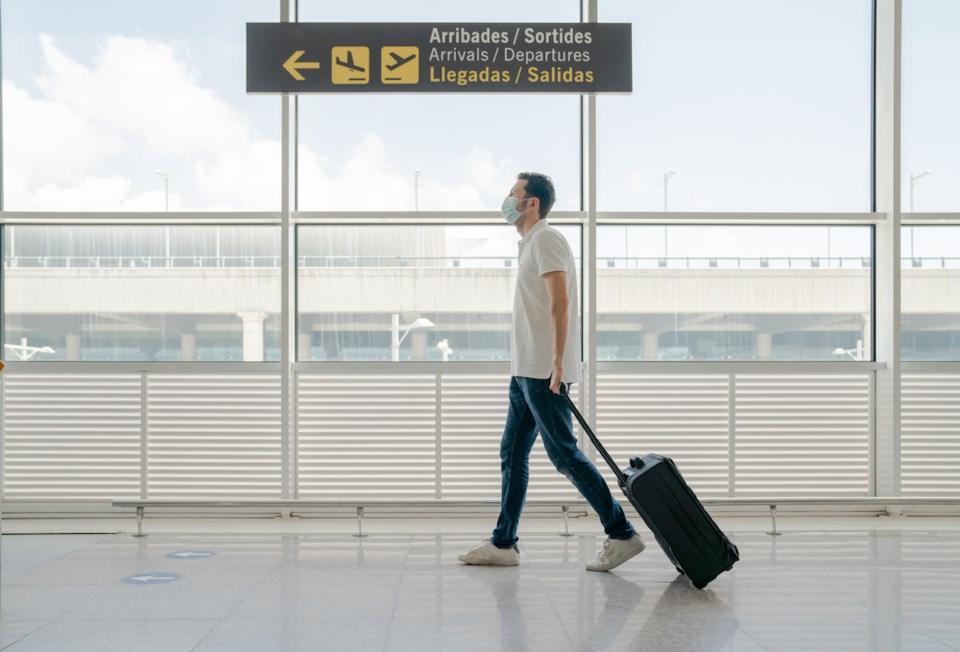The British Columbia Centre for Disease Control (BCCDC) has added five more B.C. flights to its list of public COVID-19 exposures.
The public health agency on Thursday, Dec. 17 warned passengers who travelled aboard the following flights that they may have been exposed to the coronavirus earlier this month:
- Dec. 11: WestJet 3241, Calgary to Kamloops (Affected rows 8-14)
- Dec. 6: Air Canada 45, Delhi to Vancouver (Affected rows 11-28)
- Dec. 6 Air Canada 212, Vancouver to Calgary (Affected rows 19-15)
- Dec. 6 Pacific Coastal Airlines 108, Vancouver to Victoria (Affected rows 2-10)
- Dec. 6 Pacific Coastal Airlines 457, Vancouver to Trail (Affected rows 2-10)
Thursday's update comes following numerous B.C. flights that have been flagged in recent weeks for carrying one or more individuals who tested positive for the virus since travelling, including seven recent flights Vancouver is Awesome reported earlier this week.
With the number of new COVID-19 cases remaining in the hundreds each day, B.C. provincial health officer Dr. Bonnie Henry implemented new orders last month instructing British Columbians to avoid any non-essential travel outside their home communities. Those orders have been extended until at least Jan. 8.
Your domestic flight has been identified for having COVID-19 on board. What next?
The BCCDC is encouraging travellers who recently arrived in B.C. to check the public health agency's website for updates about flights identified for potential exposures. Passengers who flew aboard a domestic flight flagged for carrying a COVID-19 case are encouraged to self-monitor for symptoms for 14 days following their flight.
While self-monitoring for symptoms of the virus— which may include fever, cough, chills, sore throat, loss of sense of smell or taste and many more—individuals should take and record their temperature daily, and avoid taking fever-reducing medications like acetaminophen or ibuprofen, if possible, for the full 14 days. The average normal body temperature taken orally is about 37°C, according to the BCCDC.
More information about self-monitoring and self-isolation is available on BCCDC's website
Pre and Post-Travel Considerations
Currently, the Government of Canada states that you should avoid all travel outside of the country until further notice due to the coronavirus pandemic. It's issued a global travel advisory that reads, "This advisory overrides other risk levels on this page, with the exception of any risk levels for countries or regions where we advise to avoid all travel."
If you do have to travel for an essential purpose, there are several things to keep in mind before you fly.
First, any passengers who have travelled outside of Canada are required to self-isolate and self-monitor for symptoms for 14 days upon their arrival. As of Nov. 21, air travellers whose final destination is Canada are also required to submit their information electronically through ArriveCAN before boarding their flight. This includes travel and contact information, a quarantine plan (unless exempted under conditions set out in the Mandatory Isolation Order), and a COVID-19 symptom self-assessment.
Travellers must be ready to show their ArriveCAN receipt when seeking entry into Canada; a border services officer will verify that they have submitted their information digitally.
Travellers who do not submit the required information digitally before boarding their flight could be subject to enforcement action, which can range from verbal warnings to a $1,000 fine. However, exceptions will be made for those unable to submit documents electronically "due to personal circumstances, such as a disability or inadequate infrastructure."
Any returning travellers who develop symptoms following their arrival in Canada should get tested for COVID-19. Individuals who test positive are required to self-isolate for a minimum of 14 days from their arrival date, or 10 days after onset of symptoms, whichever is longer.
Find out more information here.
- With files from Elana Shepert



